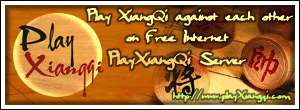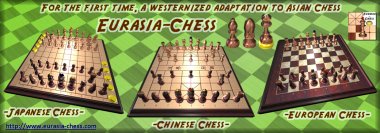

1. What is the aim of such a chessmen adaptation to Asian Chess ?
2. What kind of players will play with such chessmen pieces ?
3. Is this kind of "bastardizing" the real essence and spirit of Shogi ?
4. Chessmen specificities: Bicolor pieces and Promotion Discs
5. What is the Playability of such chessmen set ?
6. Interests of Shogi/XiangQi discovery ?
7. Why packaging all 3 chess in a single game ?

1. What is the aim of such a chessmen adaptation to Asian Chess ?
- traditional XiangQi is using Discs (7 different pieces) with Chinese characters and ...
- traditional Shogi is using two-sided trapezoidal shapes (8 different pieces + 6 promoted pieces) with Japanese characters (2 Kanji/piece).
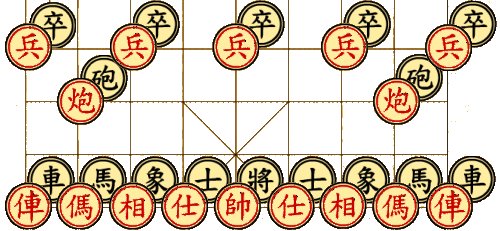 |
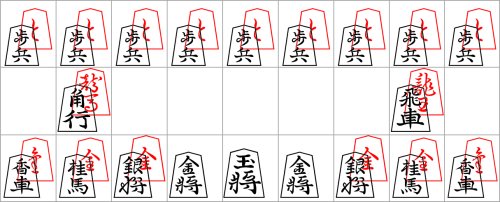 |
and this is probably the main reason such Asian chess have difficulties to spread worldwide.
On the other hand, Asian and European chess are assumed to have same origins (Chaturanga), and most of the pieces are common, with similar movements. There's only 3 new pieces (Elephant, Cannon/Lance and Silver General) added to regular western chessmen set.
Therefore, a chessmen adaptation is possible, and that's a very easy and quick way to learn/teach Asian chess for western chess players: usually, it takes 10 minutes to learn and memorize all chessmen pieces and their movements (to be compared with 5 game play with traditional equipment).
It exists already some XiangQi chessmen set, but that's the first time a chessmen adaptation is made for Shogi.
2. What kind of players will play with such chessmen pieces ?
Some people won't make the first step of learning Sinographs/Kanjis for discovering the game, but they will easily try a chessmen version of Shogi. That's why this game is mainly built for Asian Chess beginners, in order to convince western people to try out Asian chess
...
but anyone can enjoy playing all three kind of Chess (European, Chinese and Japanese) with such intrigant, surprising and beautiful “Yin&Yang” pieces. Chess sets already exist in many different versions: human or animal figurines from movies or comics, wooden Staunton models, metallic or glass shapes... Eurasia-Chess chessmen is a new variety, bicolored and with wooden Asian Staunton-like shapes.
Anyone (beginner, intermediate or confirmed player) can enjoy discovering, playing or teaching all kind of Chess with these pieces, even if bicolor pieces and magnetized-discs are "Shogi-oriented upgrades".
It is to be underlined that Shogi/XiangQi players (confirmed and novice) seem to adapt instantly to this chessmen set, without any notice (assuming they already know European chess, and its Staunton chessmen). So, if you have this set, you'll be able to play against all existing Shogi/XiangQi players population.
3. Is this kind of "bastardizing" the real essence and spirit of Shogi, by replacing the traditional pieces by chessmen pieces ?
This chessmen set is to be seen as a set for Asian chess discovery, and not a set for replacing the traditional ones. It should not be seen as a threat on the traditional sets, but on the contrary, as a new way to promote Asian chess worldwide, as European chessmen and chess symbols are already well known everywhere in the world. As a matter of fact, even if there's a great effort of such Asian chess promotion worldwide, Sinographs&Kanji seem to be the limiting factor to the spread worldwide; A westernized chessmen version of Shogi/XiangQi can be of great help for Shogi/XiangQi promotion worldwide.
If the beginner player shows interest on these firsts approaches and wants to play further against more players, or simply wants to obtain more Shogi/XiangQi news & documentation, then it is recommended to learn Kanji/Sinograph traditional pieces; but in this case, such learning will be more readily accepted/enthusiast than for an initiation.
There can be a co-existence of Eurasia-Chess chessmen and traditional pieces (keeping in mind that traditional sets will remain the reference ones). That's what can be observed for XiangQi, with new metallic figurines and traditional discs with Chinese characters. One can enjoy one or the other (or maybe both) ways of playing; They aren't rivals, in the same way as a Starwars figurine Chessmen set is not rival to the Staunton reference for European Chess .
Moreover, can we speak of a piece design issue when – outside of Japan – a great part of the Shogi games are played via internet? and thus, using westernized symbols or simplified Kanji instead of traditional Kanji?
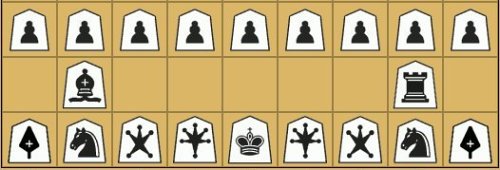 |
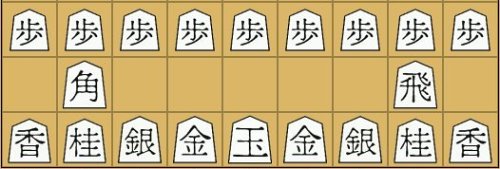 |
The most important is to be able to play the same game, with the same rules, together.
When we play Chess, we ‘re not considering its Indian origins: we primarily enjoy playing such a strategic game.
The most important in Chess games is the game itself, its rules and the capability to play against great existing player population. Having different versions of pieces is not that much important.
4. Chessmen specificities: Bicolor pieces and Promotion Discs
The bicolor and magnetized-discs specificities of Eurasia-Chess chessmen are "Shogi-oriented upgrades", but such adaptations keep the capability to play European Chess and XiangQi.
Contrary to traditional Shogi pieces (that have only one color), Eurasia-Chess chessmen have 2 colors (each player having a different color, it is easier to play with 2 colors, as it is the case for XiangQi and European Chess). That was also necessary for pieces such as Pawn, King, Rook... that don’t have a directional shape).
In Shogi, captured pieces (prisoners) can be dropped back on board. In order to allow the change of owner, when a piece is captured, each Eurasia-Chess chessman is bi-colored (Black backward, and White forward). This bi-color concept might seem a little confusing, but in fact it is very easy to use.
As a matter of fact, if you’re the "white player" you see your own pieces as Black and your opponent's as White (as do see the "Black player"). A player’s side is determined by the color of the King’s cross, in order to know who has started first.
Black / White colors of the pieces is only a way to differentiate your pieces from your opponent's one.
Unlike European chess, Shogi promoted pieces are piece upgrade (Rook become King-Rook, Bishop become King-Bishop, and other pieces are upgraded to Gold general, but all of them are restored to initial piece when captured), and quite every pieces can be upgraded (in chess, only pawn can be upgraded).
Then, a simple implementation of such mechanism is to use magnetized discs for promoting pieces, and remove such discs, when piece is captured. Promoted pieces are put on a magnetized "Golden" wooden disk. There's a stock of such disks beside the board for both players.
This disc remains magnet-attached to the promoted piece during its moves.
5. What is the Playability of such chessmen set ?
There are only two small inconvenients, but they are not critical:
a- it is difficult for a guest to watch such a game from the board-sides as he sees 2 colors for each piece;
b- each Players, and especially the white chess Player, see his/her own pieces as Black and the opponent's one as White. That could have been disturbing, however experimentation shows that it is not really a problem, as such piece colors is only a way to differentiate your own pieces from opponent’s one.
The technique of using magnetized discs for promoting pieces is slightly slower than the traditional one but fully acceptable at discovery level. You can even play blitz, provided you add 1 second to the traditional turn.
6. Interests of Shogi/XiangQi discovery ?
I feel that Shogi is the most interesting kind of chess, for the following reasons:
- its new amazing possibilities of promoting and dropping pieces.
- you can also enjoy playing aggressively, sacrificing pieces in long series of forced play until mat (Tsume: that’s the usual way to win)
- even if you lose a piece, that’s not fatal as it is in chess.
- the playing is interesting and complex during all the game as the number of pieces on board remains quite the same.
- there’s an efficient way to play with handicap, in order to equilibrate players’ strength
- you can even “play” alone, solving checkmate problems (Tsume) far more complex than European Chess’ ones as you have pieces in hand (there’s a great such library available)
- there’s quite no draw games (2%? - but it's more an arguing for confirmed players)
I encourage you to read letters from great Chess and Shogi players, in the Links pages, in order to see what Shogi can bring you. You'll see that playing Shogi will improve your European Chess Elo rating...
Discovering XiangQi is also very interesting, as this game is played by more than 500 million players, that is quite 1/3 of Asian people. It is said to be the most popular game in the world, but more particularly located on Asia.
That's a game based on blocking pieces, especially with Cannon that captures when jumping, and Knight that cannot move if adjacent square is occupied.
7. Why packaging all 3 chess in a single game ?
Eurasia-Chess chessmen are of good quality, wood-turned and handcrafted, magnet-weighted and felted, and also of recommended FIDE size (convenient for play on 5cm squares). With corresponding chess-boards, that makes a cost quite expensive (more than plastic sets) for discovering Asian chess.
On the other hand, as there's only few piece differences between Chess, XiangQi and Shogi, there's quite no extra-cost to make such chessmen pieces compatible with all 3. Chess-boards are also optimized (1 board on each side), and 2 version sets are proposed:
- STANDARD for XiangQi/Shogi discovery only (but if you already have an European chessboard, you can use such chessmen),
- and EXTRA being the complete package adding a folding wooden/nacre European ChessBoard).
Then, with a normal price for a good quality chess set, you can play/discover 2 or 3 different chess games.
- ~ -



 Shopping
Shopping

